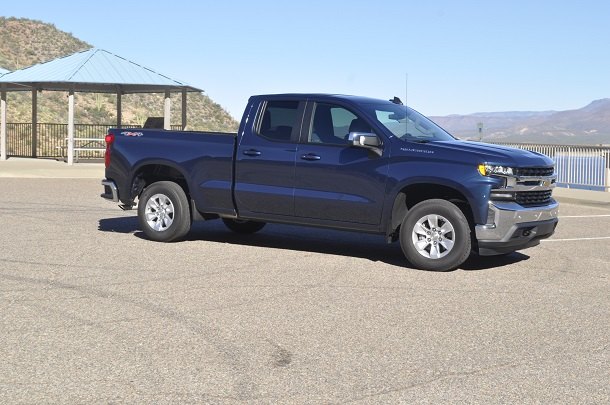2019 Chevrolet Silverado 2.7-Liter First Drive - Fighting for Value Dollars

When I was a wee lad, a four-cylinder full-size pickup was an unheard of idea. Truck buyers looked askance at any gas engine that wasn’t a V8. That’s obviously changed in recent years.
While I’ve already had a crack at the redesigned Silverado in Wyoming earlier this year, that drive focused on the V8s. So Chevy brought media to suburban Phoenix for a go-round in the four-banger, with the Chevrolet Colorado Bison also on hand to test (more on that next month when the embargo lifts).
Full disclosure: Chevrolet flew me to Phoenix/Scottsdale and paid for my hotel and meals, and they left lovely snacks in the room.
Before I could even drive the Chevy, a PR person was guiding me to a Ford F-150 Supercrew XLT with two-wheel drive and the 3.3-liter V6. Next to that truck sat a Ram with e-torque and a four-cylinder Silverado. The message was clear: Drive them back to back to back and see which was “best.”
A 10-minute test loop consisting of only right turns and suburban streets can only tell you so much, but it became clear that the Ford was outmatched by the other two. A hesitant throttle marred the driving experience, and down-market materials made the Ford feel like something I’d get for the economy price at a rental lot. While I’ve been impressed with upper-trim F-150s, the XLT doesn’t do value well.
The Ram Big Horn with the 3.6-liter was much more pleasant to drive, thanks to a responsive throttle and pleasing exhaust note. The materials also were much nicer — not the full-zoot cabin, of course, but pleasant enough.
My experience with the Chevy was much the same. As I noted earlier, the Ram has a nicer cabin across the board in terms of style, but the materials are almost on par. Like the Ram, the 2.7 has a quick throttle response, and the turbo four-cylinder (310 horsepower, 348 lb-ft of torque) offers plenty of grunt for around-town duty.
Tech-spec obsessives will note that the Ford offers up 290 ponies and 265 lb-ft of torque, while the Ram clocks in at 305/269.
I’d be interested to see how the Ford with the 2.7-liter EcoBoost V6 compares – that truck has 325 horsepower and 400 lb-ft of torque. It feels like Chevy stacked the deck a bit, especially since the XLT can be had with the 2.7 and still remain in the same price range.
We eventually left Scottsdale’s strip malls behind for the desert, and the Silverado struggled a bit as we climbed mountain grades, despite the turbo’s help. Keep it close to sea level, and the four-cylinder has more than enough power for around-town duty. Towing capacity is listed at 7,200 pounds. Unlike in Wyoming, no towing demo was available.
On-road ride and handling with the 2.7 was about the same as I experienced in the V8-powered trucks. The ride is generally smooth, at least for a truck with an empty bed, but then again, Arizona’s roads are also generally smooth. Gentle curves pose no challenge, and the steering feel is about on par for the class.
If fuel economy matters to you, the 2.7 achieves up to 20 mpg city/23 mpg highway/21 mpg combined with two-wheel drive and up to 19/22/20 with four-wheel drive.
The overall package makes sense – the turbo four offers a fuel-economy boost over the V8-powered trucks, and while the Ford and Ram have better maximum highway MPG numbers with two more cylinders, the 2.7 is on par in terms of power delivery in most settings.
My beef with this truck is two-fold. Complaint number one is that the infotainment system and interior styling remain inferior to the Ram (although my phone had no connection issues this time), even if they’re fine on their own merits. Complaint number two is that the four-cylinder’s availability is limited to specific trims – the LT and RST. While I understand that cost constraints are likely preventing the 2.7 from being available with other trims, it’s still a bummer, because you won’t be able to get this engine without sacrificing some of the upper-trim content.
That’s not to say these trims are bare bones. The LT I drove for half a day had nearly $4,000 in options tacked on to its $40K base price. Those options included dual-zone climate control, heated front seats, heated steering wheel, USB ports in the second row, remote start, trailering package, park assist, lane-change alert, blind-spot alert, and rear cross-traffic alert. That’s on top of standard features such as keyless entry, Apple CarPlay, Android Auto, Bluetooth, and in-car Wi-Fi.
Like the V8 versions, the four-cylinder Silverado is a pretty solid truck on its own merits. Still, it doesn’t turn heads the way the Ram does, and while it makes the Ford look bad when equipped with the 3.3, it may not fare so well against the 2.7 EcoBoost.
That sums up the 2019 Silverado experience – well-built trucks that are quite pleasant to drive but fall short of the competition in significant ways — styling versus Ram, power (at least on paper) versus the Ford.
Truck buyers being as brand loyal as they are, that may not matter. If you’re a Silverado owner who just gets the new Chevy every few years, you’ll be in good hands should the four-cylinder be your engine of choice. But if you’re a comparison shopper, the choice will be much tougher.
[Images: © 2018 Tim Healey/TTAC]

Tim Healey grew up around the auto-parts business and has always had a love for cars — his parents joke his first word was “‘Vette”. Despite this, he wanted to pursue a career in sports writing but he ended up falling semi-accidentally into the automotive-journalism industry, first at Consumer Guide Automotive and later at Web2Carz.com. He also worked as an industry analyst at Mintel Group and freelanced for About.com, CarFax, Vehix.com, High Gear Media, Torque News, FutureCar.com, Cars.com, among others, and of course Vertical Scope sites such as AutoGuide.com, Off-Road.com, and HybridCars.com. He’s an urbanite and as such, doesn’t need a daily driver, but if he had one, it would be compact, sporty, and have a manual transmission.
More by Tim Healey
Latest Car Reviews
Read moreLatest Product Reviews
Read moreRecent Comments
- Whynotaztec Like any other lease offer it makes sense to compare it to a purchase and see where you end up. The math isn’t all that hard and sometimes a lease can make sense, sometimes it can’t. the tough part with EVs now is where is the residual or trade in value going to be in 3 years?
- Rick T. "If your driving conditions include near-freezing temps for a few months of the year, seek out a set of all-seasons. But if sunshine is frequent and the spectre of 60F weather strikes fear into the hearts of your neighbourhood, all-seasons could be a great choice." So all-seasons it is, apparently!
- 1995 SC Should anyone here get a wild hair and buy this I have the 500 dollar tool you need to bleed the rear brakes if you have to crack open the ABS. Given the state you will. I love these cars (obviously) but trust me, as an owner you will be miles ahead to shell out for one that was maintained. But properly sorted these things will devour highway miles and that 4.6 will run forever and should be way less of a diva than my blown 3.8 equipped one. (and forget the NA 3.8...140HP was no match for this car).As an aside, if you drive this you will instantly realize how ergonomically bad modern cars are.These wheels look like the 17's you could get on a Fox Body Cobra R. I've always had it in the back of my mind to get a set in the right bolt pattern so I could upgrade the brakes but I just don't want to mess up the ride. If that was too much to read, from someone intamately familiar with MN-12's, skip this one. The ground effects alone make it worth a pass. They are not esecially easy to work on either.
- Macca This one definitely brings back memories - my dad was a Ford-guy through the '80s and into the '90s, and my family had two MN12 vehicles, a '93 Thunderbird LX (maroon over gray) purchased for my mom around 1995 and an '89 Cougar LS (white over red velour, digital dash) for my brother's second car acquired a year or so later. The Essex V6's 140 hp was wholly inadequate for the ~3,600 lb car, but the look of the T-Bird seemed fairly exotic at the time in a small Midwest town. This was of course pre-modern internet days and we had no idea of the Essex head gasket woes held in store for both cars.The first to grenade was my bro's Cougar, circa 1997. My dad found a crate 3.8L and a local mechanic replaced it - though the new engine never felt quite right (rough idle). I remember expecting something miraculous from the new engine and then realizing that it was substandard even when new. Shortly thereafter my dad replaced the Thunderbird for my mom and took the Cougar for a new highway commute, giving my brother the Thunderbird. Not long after, the T-Bird's 3.8L V6 also suffered from head gasket failure which spelled its demise again under my brother's ownership. The stately Cougar was sold to a family member and it suffered the same head gasket fate with about 60,000 miles on the new engine.Combine this with multiple first-gen Taurus transmission issues and a lemon '86 Aerostar and my dad's brand loyalty came to an end in the late '90s with his purchase of a fourth-gen Maxima. I saw a mid-90s Thunderbird the other day for the first time in ages and it's still a fairly handsome design. Shame the mechanicals were such a letdown.
- FreedMike It's a little rough...😄






































Comments
Join the conversation
I wouldn't have a problem with owning a GM truck. I think it's ugly as hell, but I wouldn't touch the 4cyl turbo any sooner than I would an Ecoboost F150. Especially the first year. I would probably just take the Ram, with the Hemi, and live with the bad mileage. I still miss my '03, only traded due to my being injured/handicapped and getting in it was a huge risk. Every time I see it around town, rusting now, I feel sad.
When are automakers going to get it through their heads? NOBODY WANTS TINY TURBOCHARGED 4 CYLINDER ENGINES IN BIG VEHICLES. This engine belongs in a Malibu, as an option, not a full size truck. Not even in a mid sized truck. All a turbo means is more moving parts, more sensors, and more things that can go wrong especially as it ages. And you've just proven the thing offers no fuel economy benefit over a modern V8. Whats next? A .75 liter 2 cylinder with quad octagonal turbos? We should be looking a turbocharging inline 6 cylinders for pickups, not 4 cylinders.